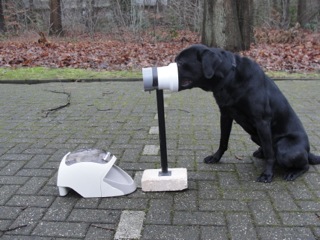Generally when one I think of dogs trained for military and police work, I envision toys as the primary motivator and choke chains and pinch collar corrections to keep the dogs in line. However, at least one police/military group in the Netherlands is training using more data-proven methods. Headed by Simon Prins, co-author of Canine Behavior Basics: A Manual for Proven Success in Operational Service Dog Training, this group’s training is based on solid principles of rewarding desired behavior (positive reinforcement), removing rewards for unwanted behavior (negative punishment), and building behaviors in little steps (shaping) so that behaviors can be learned quickly, reliably and with the least stress to the dog-handler team. This approach that they have been using since 1996 has allowed them to cut their training time down to 1/8 of the time it originally took and has allowed them to train behaviors that in the past they had only dreamed of. As you’d guess, they use some of the best technology for training, and one tool they use is the Treat&Train®. Says Prins, “We have 10 which we use regularly, as well as other remote controlled feeders which we have designed ourselves.”
Treat&Trains are used starting on day 1:
One of the first times a dog sees a Treat&Train, or remote-controlled food reward system, is during their evaluation for suitability for the program. Says Prins, “One of the test elements in selecting dogs is placing the animal and the Treat&Train in a safe environment with no distractions (an empty room), conditioning the dog to the feeder and measuring the number of trials it takes for the dog to learn.” In other words, the first test basically measures how long it takes the dog to learn that the machine dispenses treats and that the tone the machine emits means it’s going to release a treat.
Next, a novel object is placed 50 cm (20 inches) from the feeder and the dog is evaluated. Trainers measure how many trials it takes them to shape the dog to touch the object with its nose. This training is performed without giving the dog any physical cues or help from a trainer. The trainer may first reward from the Treat&Train if the dog glances at or moves towards the target and then the trainer systematically rewards behaviors that are closer to the goal behavior of touching the target with the nose. Each time the dog performs a correct behavior, the Treat&Train dispenses a treat.
The next test is the trainer shaping the push of the target with the front leg and again measure the number of trials it takes the dog to learn. But it doesn’t end there. Says Prins, “Then we place the object farther and farther away and see how quickly the animal works even when the object is moving away. During this stage, the trainer changes his position relative to the Treat&Train and varies his body language, makes random noises, moves out of site.”
What they are selecting for is a dog that can problem solve and learn quickly and isn’t overly reliant on human cues, rather than one that has to be shown exactly what to do. Prins adds, “The data also tells us how the dog copes with change.”
Once dogs are selected into the program, they are trained a number of tasks using the Treat&Train. For instance, they learn other various targeting behaviors.
They may learn to hold their nose for extended periods of time on a target when given a cue. This is often trained using multiple Treat&Trains so that the dog focuses on the behavior and doesn’t know exactly where the reward will come from. When the dog is first learning, the feeder is placed near the target so that many trials can be performed quickly. As the dog learns the behavior, the feeder is moved further away and then multiple feeders are used so that the behavior is independent of the feeder location.
A variation of target behavior is scanning. This is where the dog is trained to look at an object and to follow it with his gaze.
In this photo, the dog is looking at a target on the door. As with the previous targeting behavior, the trainer starts with the Treat&Train near the dog so that the dog can be rewarded at a high reinforcement rate.
You might wonder why you’d want to train these strange targeting exercises to a dog in training to participate in operations for the police and military. Well, that’s actually top secret. But use your imagination and notice that dogs are sometimes outfitted with interesting gear. You can also find out more in K9 Behavior Basics: A Manual for Proven Success in Operational Service Dog Training.
Why are these science-based methods required for these operational dogs?
Why are these science-based, data-driven methods important for the military dogs trained in the Netherlands? Prins states, “If you have a punishment-trained dog, in the new situation when they are not sure what to do, they are afraid they will receive punishment, even if it is mild. Dogs just stop performing and learning slows down or stops. For the most stable dogs in stressful operational situations, its more effective to condition an animal to see the world as an environment in which something positive could occur at any moment.”
The change to this system of training has paid off big! Shorter training times, more dogs trained for less money, behaviors they could never train before and more consistent, reliable dogs. Regardless of your opinions on methods of training, the bottom line is that overall, says Prins, “They lead to more successful missions!”





